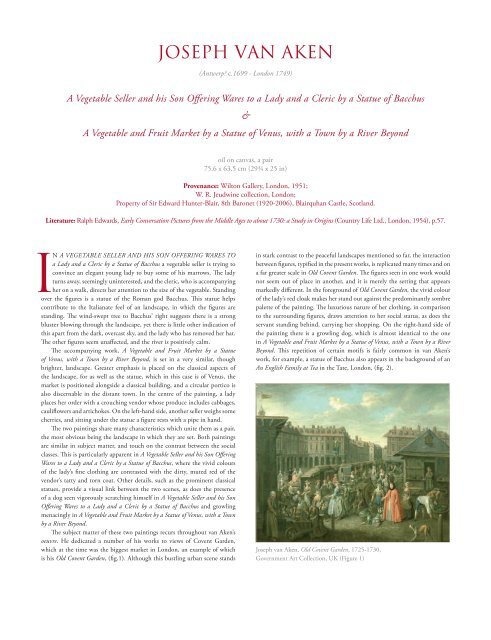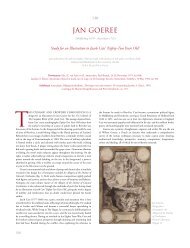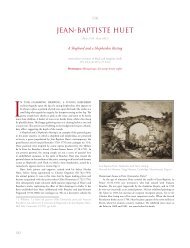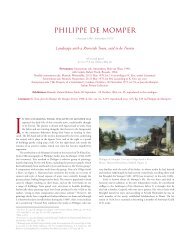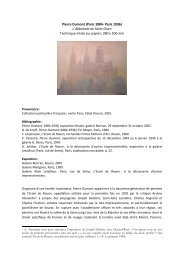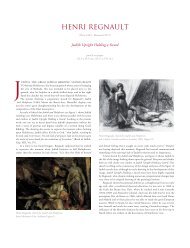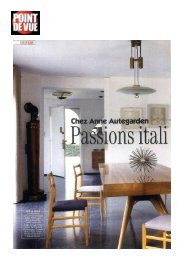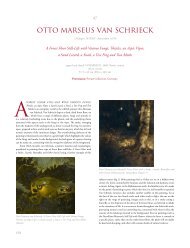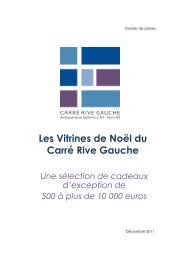Joseph van Aken - A Pair of Vegetable Seller
Joseph van Aken - A Pair of Vegetable Seller
Joseph van Aken - A Pair of Vegetable Seller
You also want an ePaper? Increase the reach of your titles
YUMPU automatically turns print PDFs into web optimized ePapers that Google loves.
In A VegetAble <strong>Seller</strong> And hiS Son <strong>of</strong>fering WAreS to<br />
a lady and a Cleric by a Statue <strong>of</strong> bacchus a vegetable seller is trying to<br />
convince an elegant young lady to buy some <strong>of</strong> his marrows. The lady<br />
turns away, seemingly uninterested, and the cleric, who is accompanying<br />
her on a walk, directs her attention to the size <strong>of</strong> the vegetable. Standing<br />
over the figures is a statue <strong>of</strong> the Roman god Bacchus. This statue helps<br />
contribute to the Italianate feel <strong>of</strong> an landscape, in which the figures are<br />
standing. The wind-swept tree to Bacchus’ right suggests there is a strong<br />
bluster blowing through the landscape, yet there is little other indication <strong>of</strong><br />
this apart from the dark, overcast sky, and the lady who has removed her hat.<br />
The other figures seem unaffected, and the river is positively calm.<br />
The accompanying work, A <strong>Vegetable</strong> and fruit Market by a Statue<br />
<strong>of</strong> Venus, with a town by a river beyond, is set in a very similar, though<br />
brighter, landscape. Greater emphasis is placed on the classical aspects <strong>of</strong><br />
the landscape, for as well as the statue, which in this case is <strong>of</strong> Venus, the<br />
market is positioned alongside a classical building, and a circular portico is<br />
also discernable in the distant town. In the centre <strong>of</strong> the painting, a lady<br />
places her order with a crouching vendor whose produce includes cabbages,<br />
cauliflowers and artichokes. On the left-hand side, another seller weighs some<br />
cherries, and sitting under the statue a figure rests with a pipe in hand.<br />
The two paintings share many characteristics which unite them as a pair,<br />
the most obvious being the landscape in which they are set. Both paintings<br />
are similar in subject matter, and touch on the contrast between the social<br />
classes. This is particularly apparent in A <strong>Vegetable</strong> <strong>Seller</strong> and his Son <strong>of</strong>fering<br />
Wares to a lady and a Cleric by a Statue <strong>of</strong> bacchus, where the vivid colours<br />
<strong>of</strong> the lady’s fine clothing are contrasted with the dirty, muted red <strong>of</strong> the<br />
vendor’s tatty and torn coat. Other details, such as the prominent classical<br />
statues, provide a visual link between the two scenes, as does the presence<br />
<strong>of</strong> a dog seen vigorously scratching himself in A <strong>Vegetable</strong> <strong>Seller</strong> and his Son<br />
<strong>of</strong>fering Wares to a lady and a Cleric by a Statue <strong>of</strong> bacchus and growling<br />
menacingly in A <strong>Vegetable</strong> and fruit Market by a Statue <strong>of</strong> Venus, with a town<br />
by a river beyond.<br />
The subject matter <strong>of</strong> these two paintings recurs throughout <strong>van</strong> <strong>Aken</strong>’s<br />
oeuvre. He dedicated a number <strong>of</strong> his works to views <strong>of</strong> Covent Garden,<br />
which at the time was the biggest market in London, an example <strong>of</strong> which<br />
is his old Covent garden, (fig.1). Although this bustling urban scene stands<br />
JOSEPH VAN AKEN<br />
(Antwerp? c.1699 - london 1749)<br />
A <strong>Vegetable</strong> <strong>Seller</strong> and his Son <strong>of</strong>fering Wares to a lady and a Cleric by a Statue <strong>of</strong> bacchus<br />
&<br />
A <strong>Vegetable</strong> and fruit Market by a Statue <strong>of</strong> Venus, with a town by a river beyond<br />
oil on canvas, a pair<br />
75.6 x 63.5 cm (29¾ x 25 in)<br />
Provenance: Wilton Gallery, London, 1951;<br />
W. R. Jeudwine collection, London;<br />
Property <strong>of</strong> Sir Edward Hunter-Blair, 8th Baronet (1920-2006), Blairquhan Castle, Scotland.<br />
Literature: Ralph Edwards, early Conversation Pictures from the Middle Ages to about 1730: a Study in origins (Country Life Ltd., London, 1954), p.57.<br />
in stark contrast to the peaceful landscapes mentioned so far, the interaction<br />
between figures, typified in the present works, is replicated many times and on<br />
a far greater scale in old Covent garden. The figures seen in one work would<br />
not seem out <strong>of</strong> place in another, and it is merely the setting that appears<br />
markedly different. In the foreground <strong>of</strong> old Covent garden, the vivid colour<br />
<strong>of</strong> the lady’s red cloak makes her stand out against the predominantly sombre<br />
palette <strong>of</strong> the painting. The luxurious nature <strong>of</strong> her clothing, in comparison<br />
to the surrounding figures, draws attention to her social status, as does the<br />
ser<strong>van</strong>t standing behind, carrying her shopping. On the right-hand side <strong>of</strong><br />
the painting there is a growling dog, which is almost identical to the one<br />
in A <strong>Vegetable</strong> and fruit Market by a Statue <strong>of</strong> Venus, with a town by a river<br />
beyond. This repetition <strong>of</strong> certain motifs is fairly common in <strong>van</strong> <strong>Aken</strong>’s<br />
work, for example, a statue <strong>of</strong> Bacchus also appears in the background <strong>of</strong> an<br />
An english family at tea in the Tate, London, (fig. 2).<br />
<strong>Joseph</strong> <strong>van</strong> <strong>Aken</strong>, old Covent garden, 1725-1730,<br />
Government Art Collection, UK (Figure 1)
<strong>Joseph</strong> <strong>van</strong> <strong>Aken</strong>, A <strong>Vegetable</strong> <strong>Seller</strong> and his Son <strong>of</strong>fering Wares to a lady and a<br />
Cleric by a Statue <strong>of</strong> bacchus (Detail)<br />
Van <strong>Aken</strong> began his career in Antwerp where he painted genre scenes in<br />
the Flemish tradition. He arrived in London with his brothers around 1720<br />
and continued to produce genre paintings as well as conversation pieces. His<br />
old Covent garden and The old Stocks Market (c.1740, Bank <strong>of</strong> England,<br />
London) show his adaptation <strong>of</strong> this genre tradition to contemporary London<br />
scenes, and the several versions <strong>of</strong> these works attest to their popularity. Van<br />
<strong>Aken</strong> also painted portraits, and his conversation pieces such as An english<br />
family at tea, betray a French influence in their lively brushwork and<br />
informal compositions.<br />
In the 1730s and 1740s, on account <strong>of</strong> his talent in rendering materials<br />
such as satin, velvet and gold lace, <strong>van</strong> <strong>Aken</strong> abandoned independent work,<br />
taking up employment as a drapery painter for other artists. He worked for<br />
many leading portrait painters <strong>of</strong> the day, including <strong>Joseph</strong> Highmore (1692-<br />
1780), Thomas Hudson (?1701-1779), George Knapton (1698-1778), Arthur<br />
Pond (1701-1758), Allan Ramsay (1713-1784) and <strong>Joseph</strong> Wright <strong>of</strong> Derby<br />
(1734-1797). Usually, these artists painted only the face <strong>of</strong> the sitter, leaving<br />
<strong>van</strong> <strong>Aken</strong> to fill in the rest <strong>of</strong> the composition. Some <strong>of</strong> these artists <strong>of</strong>ten<br />
relied heavily upon his judgement, an example being Winstanley, who painted<br />
his faces on a piece <strong>of</strong> cloth which <strong>van</strong> <strong>Aken</strong> would then paste onto a larger<br />
canvas, arranging the composition himself. However, others, such as Ramsay,<br />
sent him drawings and instructions suggesting postures and draperies. In<br />
<strong>Joseph</strong> <strong>van</strong> <strong>Aken</strong>, An english family at tea, c.1720, The Tate, London (Figure 2)<br />
<strong>Joseph</strong> <strong>van</strong> <strong>Aken</strong>, A <strong>Vegetable</strong> <strong>Seller</strong> and his Son <strong>of</strong>fering Wares to a lady and a<br />
Cleric by a Statue <strong>of</strong> bacchus (Detail)<br />
1737, the English writer and engraver, George Vertue (1684-1756), remarked<br />
that <strong>van</strong> <strong>Aken</strong> had lately excelled in painting ‘particularly the postures for<br />
painters <strong>of</strong> portraits who send their pictures when they have done the faces<br />
to be dressed and decorated by him’.¹ Van <strong>Aken</strong> was especially known for<br />
his costumes, which were inspired by those in Anthony <strong>van</strong> Dyck’s (1599-<br />
1641) paintings, as well as being derived from Peter Paul Rubens’ (1577-1640)<br />
portrait <strong>of</strong> hélène fourment (Museu Calouste Gulbenkian, Lisbon). One highly<br />
fashionable composition, closely modelled on hélène fourment, was used by<br />
Ramsay, Hudson and Wright several times, but it has been demonstrated that<br />
the design originated with <strong>van</strong> <strong>Aken</strong>. On the work <strong>of</strong> English portraitists,<br />
Vertue remarked ‘it’s very difficult to know one hand from another’, such<br />
was <strong>van</strong> <strong>Aken</strong>’s popularity.² Horace Walpole also remarked, ‘Almost every<br />
painter’s works were painted by <strong>van</strong> <strong>Aken</strong>’.³ Van <strong>Aken</strong>’s output was so prolific<br />
that it has led some to comment that English portraiture in the age <strong>of</strong> Joshua<br />
Reynolds (1723-1792) (see Inventory) would not have existed without him.<br />
Artists, to an extent, made their reputations on his ability, as his elegant poses<br />
and sumptuous draperies attracted patronage. In 1745, his services were<br />
solicited by John Robinson, a portrait painter from Bath, but <strong>van</strong> <strong>Aken</strong>’s other<br />
employers were so jealous <strong>of</strong> his ability that they threatened to withdraw <strong>of</strong>fers<br />
<strong>of</strong> employment if he agreed to work for Robinson. He received a similar threat<br />
when he was <strong>of</strong>fered work by the popular portrait painter Jean-Baptiste <strong>van</strong><br />
Loo (1684-1745). Such extreme reactions are a useful gauge <strong>of</strong> <strong>van</strong> <strong>Aken</strong>’s<br />
popularity at the time, as well as a reflection <strong>of</strong> his discreet input into the works<br />
<strong>of</strong> important artists. Paintings such as A <strong>Vegetable</strong> <strong>Seller</strong> and his Son <strong>of</strong>fering<br />
Wares to a lady and a Cleric by a Statue <strong>of</strong> bacchus or An english family at tea,<br />
exemplify the qualities that made his work a success. Both paintings depict a<br />
range <strong>of</strong> different draperies and garments belonging to rich and poor, male and<br />
female, all <strong>of</strong> which are invariably brilliantly painted.<br />
In 1748, <strong>van</strong> <strong>Aken</strong> travelled to France with a number <strong>of</strong> artists, including<br />
William Hogarth (1697-1764) and Hudson, and then by himself to the<br />
netherlands. It was on this trip that, while sketching in Calais, Hogarth was<br />
arrested as a spy and on his return immediately began his famous painting o<br />
the roast beef <strong>of</strong> old england (or Calais gate, Tate, London).<br />
Hogarth commemorated <strong>van</strong> <strong>Aken</strong>'s death in 1749 with a caricature<br />
depicting the disconsolate portrait painters lamenting at his funeral, and<br />
Ramsay and Hudson were joint executors <strong>of</strong> his will.⁴ Van <strong>Aken</strong>’s younger<br />
brother, Alexander <strong>van</strong> <strong>Aken</strong>, was also a drapery painter and was employed by<br />
Hudson after <strong>Joseph</strong>’s death. Another brother, Arnold, was also an artist, but<br />
his output was limited to small conversation pieces and a series <strong>of</strong> engravings<br />
<strong>of</strong> fish.<br />
¹ R. Edwards, ‘The Conversation Pictures <strong>of</strong> <strong>Joseph</strong> <strong>van</strong> <strong>Aken</strong>’, Apollo, XXIII,<br />
1936, p. 80.<br />
² ‘The note-books <strong>of</strong> George Vertue’, Walpole Soc., xxii, 1934, p. 117.<br />
³ Ellis Waterhouse, The dictionary <strong>of</strong> british 18th Century Painters in oils and Crayons,<br />
1981, p.377.<br />
⁴ Edwards, p. 81.
<strong>Joseph</strong> <strong>van</strong> <strong>Aken</strong>, A <strong>Vegetable</strong> <strong>Seller</strong> and his Son <strong>of</strong>fering Wares to a lady and a Cleric by a Statue <strong>of</strong> bacchus
<strong>Joseph</strong> <strong>van</strong> <strong>Aken</strong>, A <strong>Vegetable</strong> and fruit Market by a Statue <strong>of</strong> Venus, with a town by a river beyond


